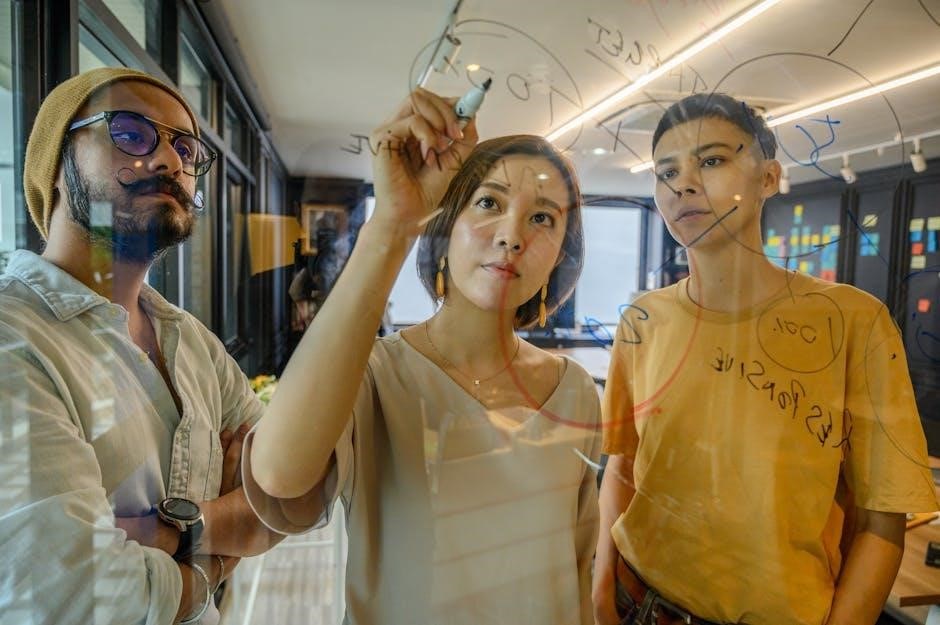
Gender, Ideas, Interactions, Institutions: An Overview
This leading textbook in gender studies explores gender through cultural norms, social interactions, and institutional systems, offering a comprehensive understanding of gender dynamics in society․
The third edition of Gender: Ideas, Interactions, Institutions offers a revised and expanded exploration of gender dynamics, incorporating intersectional perspectives and inclusive storytelling․ It introduces new coverage of nonbinary and trans experiences, reflecting contemporary societal shifts․ The text engages students through relatable examples from fiction and film, fostering a deeper understanding of gender as a social construct․ This edition emphasizes intersectionality, ensuring diverse voices and experiences are central to the narrative, making it a vital resource for modern gender studies․
Authors and Publication Details
Gender: Ideas, Interactions, Institutions, Third Edition is authored by sociologists Lisa Wade and Myra Marx Ferree, renowned for their expertise in gender studies․ Published by W․W․ Norton & Company, this edition is available in print and digital formats, including PDF․ With ISBN-10: 0393892867, it is widely recognized as a foundational text in sociology courses, offering a contemporary and inclusive approach to understanding gender dynamics in society today․
Key Themes and Structure
The textbook explores gender through three core themes: ideas, interactions, and institutions․ It examines cultural norms, everyday social dynamics, and systemic frameworks shaping gender․ The third edition features expanded coverage of nonbinary and trans experiences, emphasizing intersectionality․ Structured to build progressively, it combines storytelling, film examples, and real-world applications to engage students․ The contemporary writing style and diverse perspectives make it a compelling resource for understanding gender in modern society, offering both theoretical depth and practical relevance․

Understanding Gender as a Social Construct
Gender is explored as a social construct, examining ideas, interactions, and institutions․ The third edition offers expanded coverage of nonbinary identities and an intersectional perspective, enhancing understanding of gender’s cultural and structural dimensions․

Gender as Ideas: Cultural Norms and Beliefs
Gender as ideas examines cultural norms and beliefs that shape identities․ The third edition highlights storytelling and examples from fiction and film to illustrate how societal expectations construct gender․ By exploring diverse perspectives, it reveals how gender ideologies are formed and reinforced, emphasizing the importance of an inclusive approach to understanding these complex systems․
Gender as Interactions: Everyday Social Dynamics
Gender as interactions focuses on how individuals negotiate and reinforce gender norms through daily social dynamics․ The third edition uses storytelling and examples from fiction and film to illustrate how gender is performed and challenged in everyday life․ By examining these interactions, the text highlights how gender roles are both upheld and subverted, offering insights into the fluidity of gender expression and its impact on individuals and society․
Gender as Institutions: Structural and Systemic Frameworks
Gender as institutions examines the structural frameworks that shape gender roles and inequalities․ The third edition explores how systems like education, economy, and politics perpetuate gender norms․ By analyzing these systemic structures, the text reveals how institutions reinforce gender disparities and hinder equality; This section emphasizes the need for institutional change to achieve a more inclusive and equitable society, highlighting the real-world implications of gender studies in driving policy reforms and social justice․
Revisions and Updates in the Third Edition
The third edition incorporates updated research, contemporary examples, and expanded discussions on gender diversity, ensuring a more comprehensive and engaging exploration of gender studies․
Expanded Coverage of Nonbinary and Trans Experiences
The third edition places greater emphasis on nonbinary and trans experiences, providing deeper insights into their social, cultural, and institutional implications․ By integrating diverse perspectives, it offers a more inclusive understanding of gender identity and expression, reflecting the complexity of contemporary gender dynamics․ This expanded coverage ensures the textbook remains relevant and informative for students exploring the evolving landscape of gender studies;
Enhanced Intersectional Approach
The third edition incorporates an enhanced intersectional approach, examining how race, class, sexuality, and other identities intersect with gender․ This framework provides a nuanced understanding of how societal structures shape individual experiences․ By addressing these intersections, the text offers a more comprehensive analysis of power dynamics and inequality, equipping students with a deeper understanding of gender’s role in shaping diverse lives and societal institutions․
Inclusive and Diverse Perspectives
The third edition emphasizes inclusive and diverse perspectives, ensuring representation of varied voices and experiences․ It integrates stories and examples that reflect the complexity of gender across different cultures, identities, and contexts․ By incorporating diverse narratives, the text fosters empathy and understanding, highlighting how gender intersects with other social factors․ This approach creates a richer, more relatable learning experience, encouraging students to engage deeply with the material and its real-world relevance․

Teaching and Learning with the Third Edition
The third edition enhances engagement through storytelling, relatable examples, and a modern writing style, making complex concepts accessible and fostering a deeper understanding of gender studies․

Storytelling and Story Analysis in the Textbook
The textbook employs a storytelling approach to engage students, using relatable narratives and examples from fiction and film to illustrate gender concepts․ This method makes abstract ideas more accessible and memorable․ By analyzing stories, students gain insight into how gender shapes experiences and interactions in real-world contexts․ The use of diverse and contemporary examples fosters deeper understanding and critical thinking about gender dynamics․ This innovative approach ensures the material resonates with students, enhancing their learning experience and connection to the subject matter․
Engaging Examples from Fiction and Film
The textbook incorporates compelling examples from fiction and film to illustrate gender concepts, making them relatable and accessible․ These narratives, often featuring diverse characters and plotlines, help students connect theoretical ideas to real-world scenarios․ By analyzing these stories, learners gain a deeper understanding of how gender shapes identities, interactions, and institutional experiences․ This approach not only enhances engagement but also encourages critical thinking about the societal implications of gender dynamics, fostering a more immersive learning experience․
Modern Writing Style and Student Engagement
The third edition features a contemporary writing style that captivates students with its clarity and relevance․ By blending academic rigor with accessible language, the authors create an engaging narrative that resonates with diverse learners․ This approach fosters student engagement, making complex gender concepts understandable and relatable․ The modern style also encourages active participation, enabling students to connect the material to their own experiences, thereby enhancing their understanding of gender dynamics in today’s society․
Practical Applications and Relevance
The book provides real-world insights into gender studies, offering practical applications for understanding and addressing gender-based issues in society, policy, and personal experiences․
Real-World Implications of Gender Studies
The third edition emphasizes the practical relevance of gender studies, illustrating how gender shapes policies, institutions, and individual lives․ By exploring real-world examples, it connects theoretical concepts to everyday experiences, enabling readers to understand and address gender inequalities in various sectors․ This approach empowers individuals to contribute to meaningful social change and institutional reform, highlighting the importance of gender-aware policies and practices in creating a more equitable society․
Policies and Institutional Change
The third edition highlights the role of policies in shaping gender dynamics, emphasizing the need for institutional reform․ It explores how laws and organizational structures can perpetuate or challenge gender inequalities, offering insights into creating inclusive policies․ By examining case studies and theoretical frameworks, the text provides a roadmap for advocating systemic change, ensuring that institutions reflect equitable gender practices and promote diversity at all levels․
Empowering Individuals Through Knowledge
The third edition emphasizes how education and awareness empower individuals to challenge gender norms and advocate for equality․ By providing accessible insights into gender dynamics, the text equips readers with the tools to critically analyze and address inequalities in their personal and professional lives․ Through storytelling and real-world examples, it fosters empathy and understanding, encouraging individuals to become agents of change in their communities and beyond․
The third edition of Gender: Ideas, Interactions, Institutions stands as a pivotal resource, offering a comprehensive and inclusive understanding of gender studies․ Its impact will shape future scholarship and dialogue, ensuring continued relevance in evolving societal contexts․
The Significance of the Third Edition
The third edition of Gender: Ideas, Interactions, Institutions marks a significant evolution in gender studies, offering a more inclusive and intersectional perspective․ Revised to address contemporary issues, it expands coverage of nonbinary and trans experiences, ensuring diverse voices are represented․ Through storytelling and examples from fiction and film, the textbook engages students deeply, making complex concepts accessible․ Its modern writing style and real-world applications solidify its reputation as a gold standard for sociology of gender courses, providing a robust foundation for understanding gender dynamics․
Future Directions in Gender Studies
The third edition of Gender: Ideas, Interactions, Institutions underscores the evolving nature of gender studies, pointing to future trends like expanded research on nonbinary identities and trans experiences․ It highlights the importance of intersectionality and global perspectives, encouraging scholars to explore gender in digital spaces and emerging technologies․ By emphasizing inclusivity and real-world applications, the textbook sets a foundation for future studies that prioritize equity, empowerment, and policy change, ensuring gender studies remain relevant and transformative in a rapidly changing world․